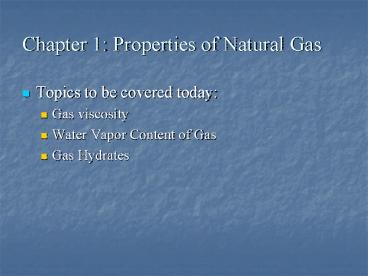Chapter 1: Properties of Natural Gas - PowerPoint PPT Presentation
1 / 24
Title:
Chapter 1: Properties of Natural Gas
Description:
rg = Gas density at reservoir pressure and temperature lb/ft3 ... Vapor Content of Gas. Bukacek Developed Empirical correlation for Water Vapor Content of ... – PowerPoint PPT presentation
Number of Views:1896
Avg rating:3.0/5.0
Title: Chapter 1: Properties of Natural Gas
1
Chapter 1 Properties of Natural Gas
- Topics to be covered today
- Gas viscosity
- Water Vapor Content of Gas
- Gas Hydrates
2
Chapter 1 Properties of Natural Gas
- Topics to be covered today
- Gas viscosity
- Water Vapor Content of Gas
- Gas Hydrates
3
Viscosity of Gas Mixtures
- Lee- Gonzales-Eakin (LGE) method (1966)
- Where
4
Viscosity of Gas Mixtures Cont.
5
Viscosity of Gas Mixtures Cont.
- And
- rg Gas density at reservoir pressure and
temperature lb/ft3 - T Reservoir Temperature in Rankin
- M Apparent molecular mass of the gas mixture
6
Example on gas Viscosity Calculations
- Calculate the gas viscosity using LGE method
- Given
- Ppr 4.46
- Tpr 1.7
- Pressure 3000 psia
- Temperature 150o F
- M 17.415
7
Solution
- Z factor from chart is 0.89
- Gas density is
8
Solution Cont.
- Calculate K, X, and Y
9
Solution Cont.
- The gas viscosity is
10
Chapter 1 Properties of Natural Gas
- Topics to be covered today
- Gas viscosity
- Water Vapor Content of Gas
- Gas Hydrates
11
Chapter 1 Properties of Natural Gas
- Water Vapor Content of Gas
- The amount of vapor present in the gas depend on
- Pressure
- Temperature
- Composition
12
Water Vapor Content of Gas
- Bukacek Developed Empirical correlation for Water
Vapor Content of Natural Gas - Where
- A(T) and B(T) are functions dependant on
temperature - W is water vapor content in lbm/MMscf
- P is absolute pressure psia
13
Water Vapor Content of Gas
- The temperature functions of Bukaceks
correlation are - Where
- T is temperature in oR
14
Water Vapor Content of Gas (graphical technique)
- McCain graphs from Bukaceks data
15
Water Vapor Content of Gas Example 1.20
- Calculate W vs. p at 300 oF
- For Pressures
- 2000
- 4000
- 6000
- 8000
16
Solution Example 1.20
- Calculating the temperature functions for
Bukaceks correlation
17
Solution Example 1.20
- Calculating W using Bukaceks correlation
18
Chapter 1 Properties of Natural Gas
- Topics to be covered today
- Gas viscosity
- Water Vapor Content of Gas
- Gas Hydrates
19
Gas Hydrates
- Hydrates are physical formation of crystalline
solids by combination of water vapor, gas and
pressure and temperature conditions - This phenomenon occurs at pressure and
temperature considerably above the freezing point
of water
20
Primary Conditions Promoting Formation of Gas
Hydrates
- Gas at or below its water dew-point
- Low temperature
- High pressure
- High velocity
- Pressure pulsation
- Introduction of a small hydrate crystal
- Agitation
- Presence of H2S and CO2
21
Operating Conditions Promoting Formation of Gas
Hydrates
- Hydrate formation at constant pressure caused by
sudden drop of temperature - Sudden expansion will be accompanied by a
temperature drop resulting in hydrate formation
22
Physical Sites for Gas Hydrates Formation
- Pipe elbows
- Orifice
- Choke
- Backpressure regulator
23
Gas Hydrates Formation Line
- The hydrates will occur on the LHS of the line
24
Gas Hydrates Formation Line
- Hydrates formation lines for methane and
different gravity gases - Avoid LHS

